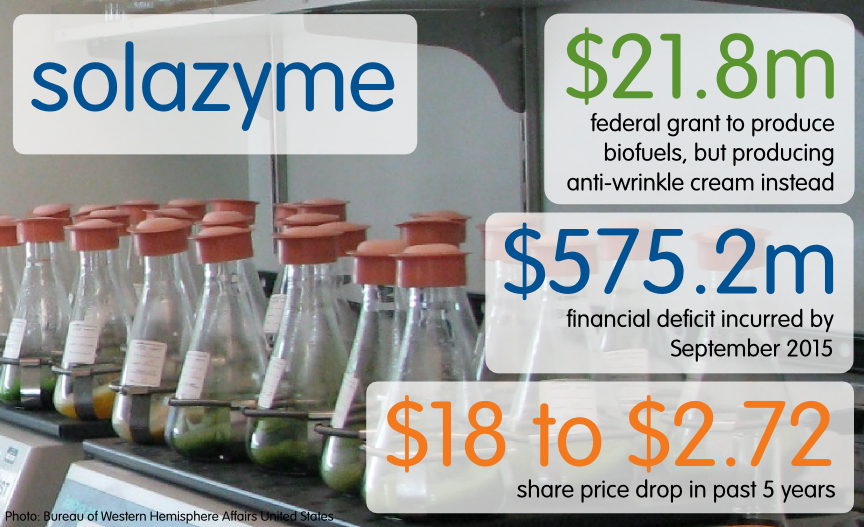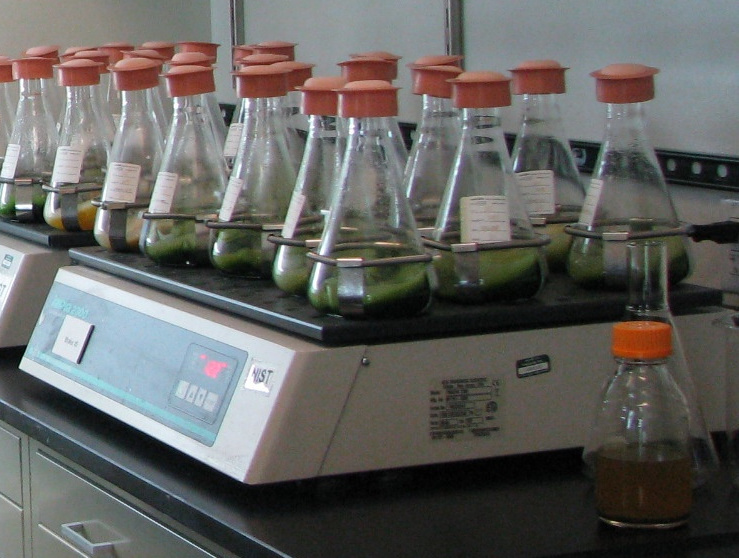 A Biofuelwatch investigation of a Californian company that has been at the forefront of genetically engineering algae. It set out to produce vast quantities of biofuels with them – but is only producing small quantities of algal oil, mainly for anti-wrinkle skin care instead.
A Biofuelwatch investigation of a Californian company that has been at the forefront of genetically engineering algae. It set out to produce vast quantities of biofuels with them – but is only producing small quantities of algal oil, mainly for anti-wrinkle skin care instead.
Download the briefing
Solazyme is a Californian company founded in 2003 with the aim of producing large quantities of algal oil for biofuels, cosmetics, nutrition, and other purposes. In the US, they have obtained permission to use four different genetically engineered strains of micro-algae for industrial production of algal oils. The US Food and Drug Administration (FDA) has permitted Solazyme to use algal oils made from one of the GE algae strains in food products. Solazyme portrays itself in the media as a company that can create an alternative to palm oil and thereby help save the orangutan.
This report examines the discrepancies between Solazyme’s public claims about the potential of their algal oil production on the one hand and the serious technical and financial limitations that they have been facing on the other hand. Based on a close examination of Solazyme’s financial reports to the US regulator (SEC), it is evident that Solazyme has consistently operated at a financial loss, with no evidence of any imminent breakthrough. Even worse for the company, they have been forced to close their main US production facility, leaving them with just one small US pilot facility and a large plant in Brazil which they have not so far managed to operate successfully.
The report further exposes a number of serious concerns associated with Solazyme and their interactions with US federal authorities/government:
Firstly, Solazyme obtained around $22 million in grants from the US Department of Energy to develop algal biofuels. Yet they have never sold any commercial quantities of algal biofuels, though in 2009 they supplied a small quantity of biofuels to the Navy at an exorbitant cost of $149 per gallon. All of their income in recent years has been derived from selling limited quantities of expensive niche products in other markets, mainly skin care products against wrinkles. It could thus be argued that the US Department of Energy has allowed biofuel subsidies to be used to develop completely unrelated products.
Secondly, the report looks at the, albeit very limited, information about Solazyme’s genetically engineered algae which is publicly available. Most of this is contained in documents on the FDA website, related to the FDA granting the company permission to sell food products made with the aid of genetically engineered algae. The FDA has a very narrow remit when considering such applications: They do not look at the potentially very significant environmental risks associated with any unintended escape of GE microorganisms, nor do they look at how credible a company’s claims that they can keep such organisms confined really are. They simply look at potential public health impacts. Yet, as shown below, even within this narrow remit, the FDA appears to have been misled by different names used for one algae species into concluding that Solazyme’s microalgae are safe for humans. In fact, the species engineered by Solazyme for use in food production happens to be linked to a rare but serious and potentially fatal disease in humans.
Finally, the report looks at the wider environmental risks associated with genetically engineered algae and with Solazyme’s concept, which involves using algae fed on sugar and thus perpetuates the existing model of biofuel production reliant on large-scale monoculture plantations, which is associated with serious environmental impacts and indirect and direct greenhouses gas emissions from land use and land use change.
Click here for a joint briefing by Friends of the Earth US and Biofuelwatch, “Beware False Promises: Algal Oils and Other Products of Synthetic Biology Aren’t About to Save the Orangutan…. But Carry Serious New Risks.” (which refers to Solazyme]
